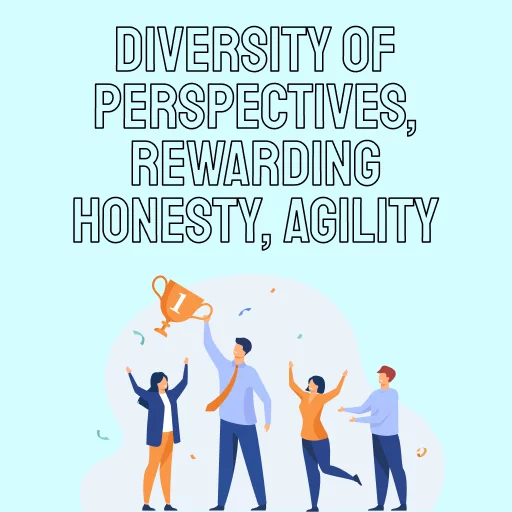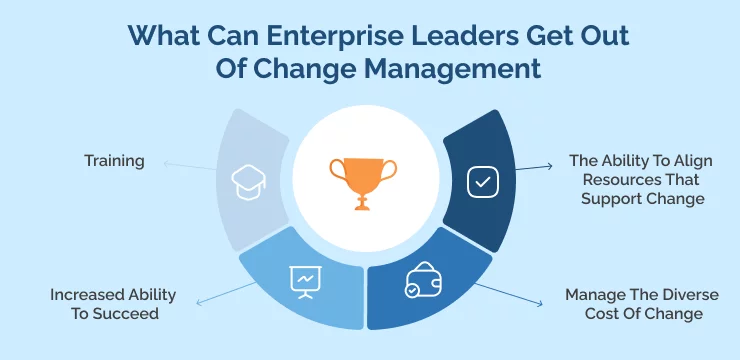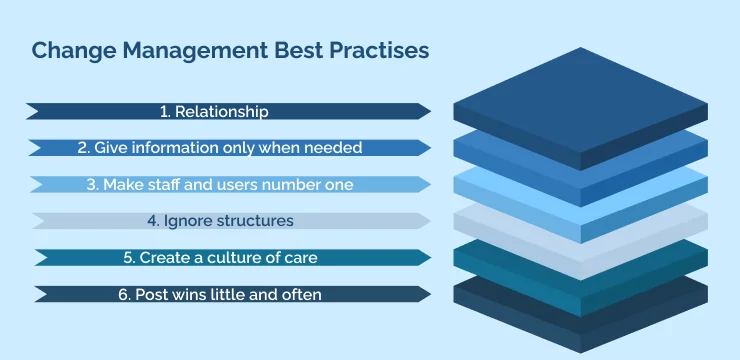
We live in an ambiguous world characterized by change. Whatever our role, we do what we can to move with these constant business changes. Team members need to take responsibility and adapt, becoming more confident in dealing with change as the paradigm shifts and leadership definitions change to include more and more people. But this starts with an effective change leader.
What is essential when managers, CEOs, CIOs, and HR specialists receive training on change management? What human psychology and business processes are involved in the practices of change management? Where do you start when the goalposts feel like they are constantly moving in the business world?
It can seem overwhelming knowing where to begin or what new skills and new practices are needed. But with the right tools, an empathetic approach, and always prioritizing staff, change management training for leaders becomes simple.
What Leaders Need To Know About Change Management In 2022

Research by Gartner Predicted that by 2021, CIOs would be as responsible for culture change as chief HR officers. This fact represents an inevitable shift from HR to IT regarding change management training, the results of which we already see through changes to job specs in 2022. It also shows a growth in the responsibility matrix as teams change their focus to drive change, investing in change management training to drive success.
Leading change begins with the staff in the most fundamental roles. This point is the key to improving change management training outcomes. The entire organization’s team feels the effect of all change initiatives as they adapt to the change program. Change management training can become more complicated within more complex organizations, but the principles remain the same, irrespective of who is receiving the training.
Inspiring Your Team To Ensure Longevity & Real Impact
Effective change leadership is the ability to relate to staff members to make them feel valued and empowered. Derek Frost, Gartner partner, outlines some of the most effective change leadership skills that can help navigate “an era of deep uncertainty, loss, and change” via Gartner.
The latest leadership style includes being personable, approachable, and emotionally open to understanding staff needs while being vulnerable and accessible for support. These are a much more modern take on the traditional depiction of a manager who may rule with discipline and power and is often critical of staff. Instead, these leadership skills and attributes are more focused on the new skills for the next generation of world-change leaders.
Transparency and vulnerability

Organizations and leaders initiating change management should understand it’s okay not to have the answer to every question all the time.
Change management leaders are advised to observe for ‘mixed signals’ emotions in a team and its members as a sign of burnout. Leaders should facilitate a safe space for colleagues to express any need or concern for their wellbeing freely.
Change leaders can show employees they’re effective role models by displaying their vulnerability and methods to adapt. This will facilitate the space for employees to display their own vulnerability should they need to.
Openness, emotion, and empathy

Change management leaders can cultivate a culture of trust and flexibility, including incorporating hybrid working and a soft-skill approach.
Change leaders should show emotion while managing in front of others to help build future team resilience. Being transparent and practical with staff about problems keeps them in the loop, reducing anxieties about unknowns.
Diversity of perspectives, Rewarding honesty, agility

The most powerful way to deal with the unknown is to throw yourself into it. Change management leaders should listen to several opinions before expressing their thoughts on the best approach. Be open and proactive about changing the route to a goal, role-modeling emotional openness, and business agility to encourage others to do the same.
On the surface, it may seem counterintuitive to be nicer to staff to inspire them. Indeed, the staff wants a strong leader they can aspire toward, earning their respect by being eloquent, charming, and clever in the business industry, right? While these things are superficially valuable, the increased communication and the strength of interpersonal bonds between managers and staff that comes through honesty, openness, and vulnerability are more practical to team members and sustainable in the long term.
What Can Enterprise Leaders Get Out Of Change Management Training?

Enterprise leaders can sometimes lose sight of what is essential in enterprises: the staff. In theory, every enterprise leader has some awareness of the team’s importance in change. Without thousands of staff, entire organizations would fall flat.
However, the lack of opportunity to be in touch with so many staff frequently because of hybrid working and executive meetings impedes the process of staff needs and experiences, directly impacting an enterprise’s ability to change. More than anything else, change management training helps remind enterprise leaders that staff needs must be at the top of the list regarding change management.
Increased Ability To Succeed
Change management training increases enterprise leaders’ skills and understanding of change initiatives. Vitally, change management training should always focus on agility and upskilling to take on more change-management-specific roles and teach the importance of leadership skills in leading change.
Leadership can take on many forms, with team members being a leader of a smaller domain, while team managers lead teams and CEOs lead companies. Learning about leadership in change management training can help enterprise leaders model positive leadership skills to all team members and acknowledge the more minor scale changes that frontline team members plan and implement daily.
The Ability To Align Resources That Support Change
Having an overview of resources is crucial for leaders to allocate resources where they are needed most to get the best out of organizational change. To lead change, enterprise leaders must understand resources as physical commodities or technological tools and mindsets that need to shift as part of the change process.
More than anything else, employee experience is the largest resource that can make or break a change strategy. Once this is understood, enterprise leaders can do what is needed to ensure success in change management.
Manage The Diverse Cost Of Change
The cost of change is not easily measured. There is the financial cost and the time resources for developing and adapting to the change. But the actual cost of a drastic change strategy is human.
Change management models such as the Kübler-Ross change management framework and the Bridges transition model help enterprise leaders to understand the human experience of change. These models show that change can be akin to grief, including loss of identity, roles, and sense of reality.
Training that helps leaders to appreciate and understand these human costs of change can empathize with staff going through these experiences. Leaders implement necessary support to managers of departments and teams to support team members with their sense of loss, meaning change is perceived positively over time.
Skills That Every Enterprise Leader Can Learn from Change Management Training

Change management training for enterprise leaders can give some theoretical understanding of what some staff experience during change strategies. But without the right skills for leading people in a change initiative, leaders cannot understand what their staff is experiencing or teach others how to learn from these experiences. In addition, without the right skills, leaders cannot implement the right changes to support staff struggling with changes as part of a new strategy.
Collaboration & Teamwork
Organizational change is individual contributors doing their bit to make up a company. Collaboration is essential for the individual contributors to group their skills and efforts to achieve the changes needed. Enterprise leaders can use this knowledge to ensure cooperation within a change strategy and use their understanding of their business and the staff within it to work out how best to promote this collaboration.
Enhanced Self-Awareness
One of the biggest problems industry leaders can face is not looking in the mirror professionally to ensure they are realistic about their business’s direction, successes, failures, and limitations. Underestimation of the opposition is another standard error. In a recent trust consumer intelligence survey, PwC found a 57-point gap between how many business leaders think consumers trust their services and products and the reality.
Being realistic about how successful a business is in all areas can mitigate against failures, saving financial and emotional waste created by poor decision-making as part of change management. For these reasons, self-awareness of what type of business person they are and how leaders perceive how they manage their business is critical. In this way, self-awareness can make leaders more effective change leaders.
Heightened Influence
With high-level skills and awareness, leaders can have a far more positive and broader impact on the behaviors of their employees. With heightened influence comes greater employee engagement, as staff members aspire to emulate the behaviors of a leader whose leadership they trust and admire.
Learning Agility
Agility is the most critical initial response to change. Learning to move, reroute, re-orient and often completely replan is the most significant factor in reacting to change, aside from staff needs.
Any change management training program must have agility and staff as its highest priorities. Leaders spearhead an agile response to unplanned change, and staff has this skill cascaded down as they observe it in their leaders.
Ability To Effectively Cope With Change
The emotional and practical application of change is demanding on everyone involved. Business leaders must look after themselves to know how to support their staff. Training needs an emphasis on self-care with advice to leaders on being able to talk to someone to offload the challenges of their change strategies.
Much pressure is on senior executives to achieve and not show their emotions. Still, part of effective change leadership is effectively coping with change openly, modeling this behavior to staff that it is okay to be vulnerable and seek support.
Organizational change
One of the essential perspectives on change management is to see the impact of change on the individual from the overview of organizational change. Leading change management training is mainly about the organization contrasted with the individual. One cannot exist without the other. It is this paradox that leaders must understand to appreciate the macro and micro scale of organizational change management.
First, the entire organization must be on board with the changes to succeed. This factor involves incentivizing employees to participate in the changes for the organization’s greater good. Employees must then communicate concerns for these to be acted on during planning, implementing, and maintaining the change strategy.
Second, the organization must understand and support the employees to contribute effectively to change. Influential change leaders know that organizational change and employee change are deeply connected.
Change Management Best Practises

Until the mid-2010s, change management training proved inadequate as change programs failed. This fact was mainly due to employees resisting the changes and a lack of support from managers using a top-down approach. Today, the emphasis for leading people is on change managers supporting employees on an equal level to understand, accept and benefit from change programs, improving the outcomes for managing change.
Leaders can follow five best practice steps to increase the chances of a change program succeeding. The key is a balance between method, agility, and psychology.
- Relationship
The meaning of relationships and how to create and maintain them are at the heart of leading people to success. How staff relates to each other defines the level of collaboration and the project’s value—for example, a team member training a new intern, project managers sharing knowledge, a change leader, and the change leader’s trainer.
- Give information only when needed
The most efficient way to address giving information to staff is to communicate as and when the information is needed. Data can then be adjusted on the fly and used as necessary. One example is hybrid working.
Specific innovations emerge from disruption, such as hybrid working becoming the norm due to Covid-19. But hybrid or mixed working will not work efficiently without assessing the best way to implement this change with an adequate change management plan. Research conducted in 2021 by McKinsey exploring whether companies were ready for hybrid working found that 68% of companies using it had no plan or ideas for addressing a strategy to get the most out of hybrid working.
In addition, a third of companies reported no change in employee productivity since hybrid and remote work began. This shortcoming is likely to be a lack of a communication plan. However, suppose the information is shared only when needed, using various forms of online communication within a structured program. Time spent is efficient, and hybrid working is optimized.
- Make staff and users number one
Implementing personalization is achieved using information based on how it relates specifically to a user or staff member. For staff and users to feel catered for by their managers and change leadership, they need to be aware that their individual needs are known. User and staff members see their place and their way of contributing to a larger mutual goal.
Ways of doing this can vary from making a point of marking staff birthdays on a calendar to showing a unique awareness of the short-notice need for leave due to caring for an elderly loved one or children. Giving holiday is one thing, but going the extra mile is to have such a strong relationship that staff comes to managers to let them know in advance that staff need leave is much more powerful.
Change managers can plan around this and put provision and replacement resources in as required. This catering to staff needs pays dividends when accepting change as part of a larger plan.
- Ignore structures
No matter where a staff member is on the hierarchy, connections are essential to running complex organizations. Managing change is built on such links, so every direct relationship formed in a workplace is precious in solidifying communication within a change program.
When a CEO or other staff member of the change management leadership comes to the office floor of any organization to meet staff and asks to be addressed by their first name, it dramatically diminishes the feeling of hierarchy. In addition, catered work functions outside of the work environment can reinforce professional relationships and improve change outcomes of an organization as staff feels more comfortable sharing challenges and concerns.
- Create a culture of care
Sharing is caring when dealing with mental health in an enterprise organization. Providing access to mental health education is one clear way of ensuring employees have the knowledge of signs to look out for in a struggling colleague. But creating a culture of shared values is more complex, and the key to ensuring employees do their best to look after each other within a cohesive team structure composed of caring practices.
Tying in care with work commitment can be simple. Visibly shared whiteboards in offices make it clear that all goals are shared, and employees need to support each other in work goals and wellbeing. In addition, as mentioned above, managers being outwardly vulnerable and talking about their personal and professional feelings can make them approachable as mental health ambassadors. Professional relationships are reinforced by increased wellbeing, improving change management outcomes.
- Post wins little and often
Organizational change does not happen overnight. It isn’t even a cut-and-dry process, with a clear beginning, middle and end. Change efforts are ongoing for any organization, so it is essential to show wins little and often to ensure rapid buy-in from investors and employees and high motivation throughout the process.
Digital change tools are excellent for communicating small but significant wins in a way people can easily access. Tying in constantly updating progress to social media post links can also be helpful in reassuring investors and employees that progress is being made by a company, despite the small scale. In these ways, posting wins little and often can be beneficial in increasing urgency and maintaining momentum for the success of a change effort.
How To Effectively Build Change Management Training For Enterprise Leaders

So far, we have covered many factors change leaders need to be aware of to implement sustainable change management processes. But what needs to be included in change management training programs for these change leaders to do their best job? Firstly, trainers must support change leaders with their creative vision for the change program.
Help Leaders To Creatively Develop Their Vision
Public speakers or script writers with a background in TED talks can help support change leaders with the creative vision for their change program. TED talks involve people speaking professionally and clearly about personal experiences and what the audience can learn from these experiences, which is what change leadership staff needs to achieve.
The change leader must believe in their vision to speak about it with authority and emotionally engage their organization’s employees more importantly. Employees will begin to share this vision, much as any society shares the idea of a leader based on the strength of their speeches.
Tools such as brainstorming and other creative exercises can help sort through ideas and pinpoint what is essential for the change leader and the company to achieve to express the vision for change. This process can take time, so patience and regular independent thought and writing work outside creative vision meetings by the change leader in training cement a solid creative vision.
Design A Straightforward Process To Help Develop That Vision
The next tool for the vision is the method. Once the change leader pins down the creative part, they are supported by the trainer to plan how to develop this vision. Various processes exist to achieve this, such as methods of process mapping. But the critical factors are that the process is precise, methodical, and works in a way the change leader understands.
Create A Budget, Cost Estimate & Align Necessary Resources
Any vision for change will not be sustainable without thorough costing. The change leader needs to ensure adequate resources exist to carry out the change plan, bearing in mind all the below factors and ensuring budgeting within change initiatives. Success is an outcome of planning and agile budgeting.
- Training – Buying training programs and trainers can be costly
- Communication – This can involve PR staff and legal specialists brought in to represent the interests of organizations
- Restructuring – Redundancy payments to staff or relocation costs to new organization premises are examples of this.
- Branding – Branding may need to be changed, involving design fees and replacing signs on vans, buildings, and stationary
- Resources – This can involve time, effort, and staff resources, which is difficult to budget as it relates to human output but needs to be included by the change leader
When these budgetary considerations are in place for an organization, they are adjusted over time to ensure they remain relevant. This process can be a frustrating and sometimes disheartening but essential part of the change process, as it is difficult to predict how a budget will change over time. Change management should seek support to address potential stress increases during the drawing up of budgeting.
Decide Which Type Of Training Works Best For Your Specific Needs
Different change leaders work in different ways. Do you prefer in-person training, training virtually using training software, or applying what you have learned in a practical sense as you go along? This factor is based chiefly on personality but partly due to the type of company. For a company with a more creative emphasis, the change leader may require different training that appeals to a more diverse set of creative skills and visual representations.
For a company creating millions of products a year, numbers and figures may be a better way of understanding change management and communicating this to staff. The main factor is that the change leader speaks with their trainer beforehand and shows what works for them. The trainer needs to act on this to ensure adequate training.
What Is The Key To Leading Change?

Change is people. Research shows that influential change leaders deeply understand and appreciate people as the core of change. Knowing staff and how to meet their needs and look after and motivate them are crucial to achieving a change strategy. At the heart of looking after team members is a well-trained change leader.
The relationship between the change management trainer and the change leader is vital. Once trust is established between the trainer and change leader over time, change leaders can learn how to carry out the required skills to deal with any change, be it the Russia-Ukraine war or Covid-19. It is up to change management trainers to teach change leaders how to achieve this skill.
Countless examples of research have shown change and the act of adapting to be a very complex concept. Most change leaders will go through some form of distressing experience when dealing with business change, let alone selling this idea to employees. So above all, change leaders need to be encouraged to be aware of their mental health to ensure they stay motivated, focused, and at low-stress levels because they will undoubtedly be dealing with the stress of others when it comes to change strategies.
Tristan Ovington
Tristan Ovington is a professional senior writer and journalist, specializing in providing expert insights on various topics such as digital adoption, digital transformation, change management, and Cloud apps. He delivers his knowledge through accessible online content that is data-driven and presented in a friendly tone, making it easy for readers to understand and implement.



